Global Journal of Zoology
Diversity and Temporal Dynamics of Insect Communities in Tunisian Tomato Field Crops: A Case Study in Sidi Bouzid
Rasmi Soltani1,2* and Eya Chalbaoui3
1Regional Centre of Agronomics Research in Sidi Bouzid, Km 6, Road of Gafsa, B.P. 357, Sidi Bouzid, 9100, Tunisia
2Laboratory of Production and Protection for Sustainable Agriculture, University of Sousse, Chott Meriam, Tunisia
3National Agronomic Institute of Tunis, Tunisia
Cite this as
Soltani R, Chalbaoui E. Diversity and Temporal Dynamics of Insect Communities in Tunisian Tomato Field Crops: A Case Study in Sidi Bouzid. Glob J Zool. 2024;9(1):019-025. DOI: 10.17352/gjz.000032Copyright
© 2024 Soltani R, et al. This is an open-access article distributed under the terms of the Creative Commons Attribution License, which permits unrestricted use, distribution, and reproduction in any medium, provided the original author and source are credited.Insect populations play a vital role in agricultural ecosystems, affecting crop productivity and overall ecosystem health. This study was conducted in three locations, El-Mzara 1, El-Mzara 2, and Zaafriya, in Sidi Bouzid governorate, Tunisia, and aimed to assess the diversity and abundance of insects associated with tomato crops using water traps from late March to early June 2021. The captured insects were collected and identified employing the RBA method. A total of 603 insects were captured. This biodiversity belonging to nine orders encompasses a total of 108 morpho-species distributed into 46 families. Results revealed that Coleoptera and Hymenoptera were the most abundant orders, while Hymenoptera exhibited the highest diversity with 34 morpho-species. The Shannon and Simpson indices indicated high diversity and even distribution of insect species in Mzara 1. The Margalef index suggested a relatively high level of species richness in this site. The temporal analysis of insect biodiversity showed variations in the abundance of different orders throughout the tomato cropping season. Hymenoptera species peaked during the flower stages, coinciding with their role as pollinators. Hemiptera species were most abundant during the fruit set and growth stages, which correspond to their harmful impact on tomato leaves and fruits. Lepidoptera species showed increased abundance during fruit set and growth stages as well. These first findings contribute to our understanding of the insect community structure within tomato crops. The data obtained serve as a valuable baseline for further research by identifying and monitoring the key insect species and their auxiliaries.
Introduction
Insects, as the most prevalent form of animal biomass and life on earth, are found abundantly in all terrestrial ecosystems occupying diverse trophic niches and performing a wide range of ecological functions contributing significantly to the overall functioning of ecosystems [1]. Insect biodiversity in agricultural systems is an important area of study, as key components present in diverse ecosystems they play a vital role in the proper functioning of these ecosystem processes [2]. These functions include ecosystem cycling, pollination [3-5], breaking down organic matter (decomposition), and controlling pests (predation/parasitism) [5,6]. Insect biodiversity ensures the preservation of these ecosystem services, which contributes to higher crop yields, improved food security, and greater environmental sustainability [7]. However, the major threats to insect biodiversity in actual intensified agriculture reside in the overuse of external inputs (pesticides, fertilizers) and the changes in agricultural practices causing the destabilization of ecosystems and then loss of natural habitats. These factors can lead to a decline in insect populations, which can have negative consequences for agricultural productivity and ecosystem health [8,9].
Tomato (Lycopersicon esculentum Mill.) belongs to the Solanaceae family including more than 3000 species such as pepper, potato, eggplants, and tobacco [10]. Tomatoes are a very popular vegetable crop cultivated for their fruit which represents one of the most consumable fruits in the world. Additionally, tomato fruits are known for their high nutritional value, rich in vitamins, minerals, organic acids, and dietary fibers, for humans. It is utilized as a fresh crop or could be processed into various forms such as paste, puree, and juices [11]. In 2020, worldwide tomato production exceeded 187 million tonnes on 5 million hectares achieving an average yield of 37 metric tonnes per hectare [12,13]. In Tunisia, this culture occupies a significant portion of the agricultural outputs and was cultivated both in open fields and under greenhouses. In 2021, the cultivated land area occupied by this culture was estimated to be 24.510 hectares with a total production that peaked at over 1.416 million metric tons [13,14].
Tomatoes are susceptible to a wide range of pests (insects, diseases, and weeds) that reduce yields and the commercial quality of fruit [15,16]. The severity of infestation as reported by [15] varies depending on the location and time of year. The key pests affecting tomato crops include the African bollworm, Helicoverpa armigera; tomato leaf miner, Tuta absoluta; whitefly, (Bemisia tabaci); thrips, Frankiniella occidentalis; aphids and various mites, with the red spider mite being particularly problematic [15-17]. Nowadays, pest control in agricultural systems is highly dependent on the use of pesticides. While they offer an efficient and rapid solution in protecting crops from pests and diseases and in increasing production [18], the continuous use of pesticides can also have negative impacts on agricultural systems including harmful effects on non-target organisms (beneficial insects, birds, and small mammals), residues in food and the environment which can persist for a long time and can accumulate in the food chain, development of resistance making pests harder to control and negative impacts on human health who come into contact with them. Consequently, pesticide use should be carefully managed to minimize their negative impacts on agricultural systems and the environment.
The limited diversity of planned crop systems has significant implications not only for production but also for the overall biodiversity of an ecosystem. This influences the diversity and abundance of associated biota, including pest populations, soil insects, and microorganisms, which, in turn, impact plant and soil processes [19]. Insects are considered valuable indicators of ecosystem health, but incomplete knowledge and limited resources pose significant challenges to the study of insect biodiversity [20]. So, understanding the ecological role of insects can help us acknowledge their significance in maintaining sustainable agricultural systems and ensuring food security in the future [21].
Until now, no study has assessed the diversity and the abundance of insects associated with tomato production in central West Tunisia. The objective of this paper was to highlight the use of water traps as the primary sampling method and emphasize the focus on insect diversity and abundance using Rapid Biodiversity Assessment (RBA) within the specific context of seasonal tomato crops in Sidi Bouzid from central western Tunisia.
Material and methods
Study sites
The study was conducted in two locations, El-Mzara and Zaafriya, in the Sidi Bouzid governorate, located in central west Tunisia. It is a continental zone situated in the upper arid bioclimatic stage characterized by irregular and low rainfall rates in winter, early springtime, and hot summers, marked by frequent heat waves. The annual averages of temperature and rainfall are, respectively, 18.6 °C and 473.9 mm.
These locations are known for diversified agricultural production, mainly seasonal tomato cultivation. A sample of three tomato orchards of the variety « Savera » was selected randomly: two in the El-Mzara site from Bir El-Hfey delegation, covering 2 ha (34°58’31.9”N 9°17’22.5” E) and 10 ha (34°58’31.3”N 9°17’22.4” E), respectively, and the other spanning 4 hectares located in the site of Zaafriya (35°02’14.1”N 9°18’31.9”E) from the western Sidi Bouzid delegation.
Insect collection and identification
Field surveys were carried out in 2021 to gain a preliminary understanding of the general situation of insect biodiversity and species composition in tomato orchards in the study area. Insects were collected for almost one crop cycle; starting one week after the transplanting stage until fruit maturity, specifically for 12 weeks from the last week of March until the first fortnight of June. Water traps, also known as pan traps, were used in this study. They consisted of shallow containers with a volume of 5 L filled two-thirds with water, to which drops of laundry detergent were added to preserve and prevent the escape of trapped insects. This non-selective method was particularly effective at collecting small and flying insects. Pan traps are relatively easy to set up and maintain. Additionally, they can be standardized and replicated across different sites and periods, making them useful for comparing insect diversity and abundance.
Ten pan traps of different colors were placed in the field at the beginning of the fourth week of March; positioned on the soil between rows of plants spaced 20 m apart. Sampling was conducted every week and the total population was analyzed monthly. Captured insects were collected in plastic cylindrical vials filled with 70% alcohol and then transferred to the entomology laboratory of the Regional Centre for Agricultural Research of Sidi Bouzid for subsequent identification.
Sorting and counting
Insect identification was based on the adoption of the Rapid Biodiversity Assessment (RBA) method which was used to quickly assess the biodiversity of an area. This method was the most suitable in our case because of the limitation of time and available resources to conduct a more detailed study. The RBA was the most suitable method to provide a preliminary overview of the biodiversity of an area and to identify if there are significant species that require particular attention and protection. For this reason, specimens for each collection date were treated separately by counting their population and placing a sample in an Eppendorf tube for biodiversity study. In this case, the attributed nomenclature was morpho-species instead of species. Researchers reported that due to time and taxonomic limitations, we were unable to compare the taxonomic identity of morpho-species across different sites. Therefore, we could not definitively determine the actual number of morpho-species for each land-use type and overall [22].
To identify and differentiate between tomato crop pests and auxiliaries, we used a stereomicroscope (Konus, #5424) and appropriate keys such as those mentioned by Baraud J. [23] and Delvare G. & Aberlenc H. P. [24].
Data analysis
Data on species composition was analyzed using statistics. Graphics were drawn using Excel (Microsoft Office 2010). The diversity indices Shannon-Wiener, Evenness, Simpson, Dominance, and Margalef were calculated using the PAST software ver.4.4.
Results
Analysis of the general biodiversity
It appears from this study that the collected insects are abundant and diversified in tomato fields. The used traps allowed for catching a total number of 603 insects distributed in 9 orders (Figure 1) and 46 families during the period of study.
Figure 1 shows the diversity of insect families by order in the study area. Among the number of collected morphospecies, the most abundant orders were Coleoptera and Hymenoptera with, respectively, 23.91, and 21.74%, followed in third position by Diptera and Hemiptera with everyone 19.57% of the total identified families, then by Lepidoptera with 4 families and Orthoptera counting 2 families. The least diversified orders were Neuroptera, Psocoptera, and Thysanoptera which everyone was represented by only one family.
The RBA method permitted to identification of a total number of 110 morpho-species that were captured in tomato orchards during the period of study. Figure 2 revealed the distribution of these captured morpho-species and the number of identified families by order. Results revealed that Hymenoptera was the most diversified order grouping about one-third of this entomofaune with 34 morpho-species (30.91%) followed by Diptera, Coleoptera, and Hemiptera orders with, respectively, 26 (23.64%), 21 (19.09%) and 20 (18.18%) morpho-species. However, the Lepidoptera order was represented by 4 morpho-species (3.64%). The least biodiversity was observed in the orders of Orthoptera with two identified morpho-species (1.82%), Neuroptera, Psocoptera, and Thysanoptera with one species (0.91%) for each order.
Until now, there has been no work interested in the study of the entomofauna biodiversity in Sidi Bouzid governorate. Based on the diversity indices calculated for the entomofauna in tomato orchards at the three sites of Mzara 1, Mzara 2, and Zaafria (Table 1), there are some notable patterns in the abundance and distribution of insects across the sites. In terms of taxa, Mzara 1 had the highest number of distinct insect taxa with 77, followed by Mzara 2 and Zaafriya with 70 and 72, respectively. However, when considering the number of individuals, Zaafriya had the highest count with 259, while Mzara 1 and Mzara 2 had 188 and 156 individuals, respectively. The dominance index was similar across all three sites at approximately 0.039, indicating a relatively even distribution of insect species. However, when considering the Shannon and Simpson indices, Mzara 1 had the highest values of 3.81 and 0.96, respectively, suggesting a high level of diversity in that specific site. The evenness index was highest at Mzara 2 with a value of 0.62, suggesting a more equitable balance in the distribution of insect species at that site. Finally, the Margalef index ranged from 12.78 to 14.51, with Mzara 1 having the highest value, suggesting a relatively high level of species richness at that site. Overall, these diversity indices indicate variations in the abundance, richness, and distribution of insect species across the three sites, providing insights into factors that may impact the overall health and productivity of tomato orchards in these regions.
Evolution of insect biodiversity throughout the cropping season
The evolution of the entomofauna biodiversity by order within water traps was represented according to time and phenological stages of tomato in Figure 3. This graphic showed that the general evolution of morphospecies belonging to different orders presents variations according to time, expressed in weeks, and which refer directly to the stages of development of tomato culture in the field from transplantation to fruit maturity and harvesting.
As a first remark, the different curves relating to different orders have almost the same appearance. For all orders, the weeks W2, W4, and D4-5 were characterized by a decrease in the number of captured insects. The cause is due to climatic conditions particularly the descent of temperatures and sometimes the registration of rainy days during these dates which influenced the activity of all insects.
When analyzing the biodiversity, the Hymenoptera order represents the most diversified relating to species (Figure 2) and grouped in tomato orchards a total of eleven families identified as follows: Andrenidae, Apidae, Halictidae, Formicidae, Megachilidae, Tenthredinidae, Ichneumonidae, Sphecidae, Scoliidae, Vespidae and Braconiidae. In Figure 3, the evolution curve of this order presented 3 important peaks registered during W1, W3, and D3-4. In the same figure, the superposition of the biodiversity curves with the developmental stages of tomato shows that these peaks coincide with the presence of flowers during the stages of (vegetative development - bloom) and (bloom – fruit set). The composition of this order which grouped the majority of pollinator species can explain its dominance during this period.
Concerning the phenology of tomatoes, the two main peaks of the Hemiptera order are recorded during the 2 successive stages (Bloom – Fruit set) and (Fruit set - Fruit growth). Species belonging to this order, which includes plant bugs and leafhoppers as well as other families, are known to be harmful to leaves and fruits after fruit set and the beginning of their growth period. Indeed, they attack the tender tissues of leaves and young fruits inducing their deformation and this explains the abundance of morphospecies belonging to this order during these two periods. Hemiptera was represented by 9 families Aphididae, Cicadellidae, Rholpalidae, Miridae, Scutelleridae, Reduviidae, Lygaeidae, Pentatomidae, and Delphacidae. This order contains both harmful species to tomatoes and beneficial insects against some pests.
About Lepidoptera, their numbers are relatively low at the beginning of the tomato cycle. Their peaks are observed mainly at the fruit-set stage and during fruit growth. It is during this stage of the tomato cycle that the fruit will increase in size to be more attractive and susceptible, especially for populations of Tuta. absoluta belonging to the Gelichiidae family and the Noctuidae Helicoverpa armigera as well as other lepidopteron species.
The order of Diptera is characterized by the presence of two peaks, the first at the vegetative development-bloom stage (W4), and the second largest peak compared to the other insect orders is recorded at week 9 which corresponds to the fruit set stage and fruit growth. The first peak is partly explained by the fact that certain Diptera species are pollinators such as hoverflies which are also bio-indicators of biodiversity. The second peak can be explained by the improvement of climatic conditions and the diversification of species belonging to this order. Between recorded and identified families we cited Anthomyiidae, Asilidae, Bombyliidae, Calliphoridae, Culicidae, Muscidae, Syrphidae, Tachinidae, and Tephritidae.
The interpretation of the figure revealed that the curve presenting the coleopteran order has 3 peaks, the third (D3-4) of which is the highest. From a morphospecies point of view, this increase is the most diversified; but without relation to tomato development. The period between the first and the second peak (W3 and D3-4) was characterized by moderately high temperatures which are favorable to the development of beetles. Between D3-4 and D4-5, temperatures dropped with the fall of some rain, which explains the fall in the number of captured insects.
Figure 4 shows the abundance (number of individuals) of different orders of insects in different tomato orchards for a cropping season cycle over three months between the last decade of March and the first half of June. Based on the figure provided, the maximum insect population was recorded during April (48.09%) and May (34.99%) which coincides with the existence of different phenological stages of tomato (vegetative, blossom, fruit set, and fruit growth).
During this study, Hemiptera represents the most abundant order of insects in tomato crops. The main activity relative to this order was registered during April and May, with respectively, over 100 individuals and 63 individuals. Coleoptera, Hymenoptera, and Diptera are also relatively abundant, with over 40 individuals each month. Lepidoptera and Hemiptera are relatively more abundant in May than in the other months. At the end of the cropping season and more precisely in the first half of June, marked by tomato fruit ripening, the total captured insects represent 6.06% of the entire seasonal captures revealing that the abundance of most orders decreases with several orders having no individuals counted. During this period, the order of Lepidoptera was the most abundant marked by the presence of the two major pests Tuta absoluta and Helicoverpa armigera specialized in attacks on tomato fruits. Neuroptera, Thysanoptera, and Psocoptera represented, respectively, by the species Chrysoperla cranea, Frankiniella occidentalis, and Elipsocus sp., have relatively low abundances across all the seasons, with only a few individuals counted. It's important to note that this figure provides only a snapshot of insect abundance in tomato orchards west of Sidi Bouzid during this specific period, and may not be representative of different locations or times.
Discussion
The identification work of the entomofauna has reported 9 orders which were distributed in 46 families; among them, 12 families were recognized as pests and 12 other ones as beneficial (auxiliaries and pollinators). This number proves that vegetable crops and tomatoes in particular represent an important reservoir for insects.
So far, there has been no work done on the diversity of entomofauna associated with vegetable crops including tomatoes in Tunisia. For this reason, we will try to discuss our results with other works carried out around the world. Similar results were obtained from the inventory that has been done in tomato fields in Benin and they have shown that insects associated with tomato crops belonged to 9 orders of which the Lepidoptera were the most dominant and diverse with 4 families and 7 genera and species [25]. Orthoptera, Hemiptera, Coleoptera, and Diptera came next and they were divided into 26 families and 37 genera and species. Also, Son D, et al. [26] have determined the diversity of associated insects to tomato cultivation in Burkina Faso and the main orders identified were Hymenoptera, Coleoptera, Hemiptera, and others and which were also divided into 42 families. They also mentioned that the main pests encountered belonged to the families of Aleyrodidae, Aphididae, Acrididae, Agromyzidae, Arctiidae, Gelechiidae, Noctuidae, and Tephritidae.
In addition, the work of Tendeng E, et al. [27] made it possible to make an inventory of the pests and auxiliaries of vegetable crops in lower Casamance in Senegal; a total of 17 families of which 38 genera and 35 species were recognized as pests, and for the auxiliaries, 9 families including 13 genera and 11 species were mentioned.
In north Cameroun, Patouma L, et al. [28], working in the entomofauna associated with tomato crops using an aspirator and sweep net revealed the identification of eight orders comprising 21 families and 22 genera [28]. Among these insect orders, Coleoptera and Hemiptera stood out as the most diversified with 6 families each followed closely in second position by Lepidoptera with 4 families then Orthoptera with 3 families. While the orders Hymenoptera, Neuroptera, and Diptera had the lowest diversity with only one family for each. Our findings agree in part with those mentioned by Tendeng E, et al. [27] mainly in the diverse position of certain orders as Coleoptera, Hemiptera, and Neuroptera and completely disagree with others orders like Diptera and Hymenoptera. These differences in findings are due to the methods of biodiversity study adopted in each study.
Limitations and future perspective
This study is limited by its restricted geographical scope, as it was conducted in only three locations within a single governorate in Tunisia, which may not represent a wide range of agroecosystems. The short temporal period, covering just a few months, probably overlooks seasonal or year-round variations in insect biodiversity. The study also employs a single trapping method, potentially limiting the diversity of captured insects. To address these limitations, improvements in study design and methodology are required to enhance the understanding of insect biodiversity and their ecological implications.
In perspective, future studies should expand the spatial and temporal scope to include diverse agroecosystems and multiple growing seasons of tomato crops, providing a wider understanding of insect biodiversity and dynamics. Employing multiple trapping methods alongside water traps is essential to capture a wider range of insect species and behaviors, thereby enhancing the comprehensiveness of diversity studies. Integrating molecular tools with morpho-species identification will further ensure precise and accurate species identification. Additionally, investigating the specific ecological roles of key species, such as pollinators, predators, and pests, is crucial for understanding their impact on tomato crops. This last step can permit to evaluation of the possibility of enhancing the use of beneficial insects in an integrated pest management strategy. It can also help research by being a starting point for the implementation of methods that will help to control these insect pests.
Conclusion
The use of water traps constitutes a common method to study and evaluate insect diversity in agricultural systems. They offer a non-selective sampling approach and are relatively inexpensive and easy to set up and maintain. Depending on the size of the trap and the duration of sampling, a large number of flying insects can be captured, providing a comprehensive picture of the insect community. However, water traps are limited to flying insects and may not capture all species present in the agricultural system. In addition, the distribution of traps can affect the insects captured, and spatial variation should be considered when interpreting results. To gain a more comprehensive understanding of insect communities, water traps should be used in conjunction with other sampling techniques.
This study conducted in Sidi Bouzid from central west Tunisia for three months permitted us to make a preliminary inventory of the entomofauna present in tomato fields and to evaluate their diversity. Overall, 46 families distributed into 9 orders have been inventoried among which both harmful and beneficial species have been encountered in this case. The main orders to which pests belong were Heteroptera, Homoptera, and Lepidoptera. Other pollinators and auxiliaries belonged to the Diptera, Coleoptera, and Hymenoptera orders.
April and May constituted the two most critical months for tomato crops due to the damages caused by the presence of the most harmful species belonging to Hemiptera, Lepidoptera, and Diptera orders. These obtained results constituted the first database for knowing the general distribution and the classification per order of the entomofauna associated with tomato crops in the different plots of the study area of Sidi Bouzid West.
The authors sincerely thank the farmers in the region for their invaluable cooperation and for generously allowing unrestricted access to their orchards.
Author contributions
Rasmi Soltani: Conceptualization; data curation; formal analysis; investigation; methodology; validation; visualization; writing – original draft; writing – review and editing. Eya Chalbaoui: Conceptualization; data curation; formal analysis; investigation; writing – original draft.
- Gullan PJ, Cranston PS. The Insects: An Outline of Entomology. Blackwell Publishing; 2010;584. Available from: https://ibimm.org.br/wp-content/uploads/2017/05/The-Insects-An-Outline-of-Entomology.pdf
- Kim KC. Biodiversity, Conservation, and Inventory: Why Insects Matter. Biodivers Conserv. 1993;2:191-214. Available from: https://doi.org/10.1007/BF00056668
- Gabriel D, Tscharntke T. Insect Pollinated Plants Benefit from Organic Farming. Agric Ecosyst Environ. 2006;118:43-48. Available from: https://doi.org/10.1016/j.agee.2006.04.005
- Lonsdorf E, Kremen C, Ricketts T, Winfree R, Williams N, Greenleaf S. Modelling Pollination Services across Agricultural Landscapes. Ann Bot. 2009;103:1589-1600. Available from: https://doi.org/10.1093/aob/mcp069
- Slade EM, Riutta T, Roslin T, Tuomisto HL. The Role of Dung Beetles in Reducing Greenhouse Gas Emissions from Cattle Farming. Sci Rep. 2016;6:18140. Available from: https://doi.org/10.1038/srep18140
- Bell JR, Traugott M, Sunderland KD, Skirvin DJ, Mead A, Kravar-Garde L, et al. Beneficial Links for the Control of Aphids: The Effects of Compost Applications on Predators and Prey. J Appl Ecol. 2008;45:1266-1273. Available from: https://doi.org/10.1111/j.1365-2664.2008.01479.x
- Pywell RF, Heard MS, Woodcock BA, Hinsley S, Ridding L, Nowakowski M, et al. Wildlife Friendly Farming Increases Crop Yield: Evidence for Ecological Intensification. Proc R Soc B. 2015;282:2015-1740. Available from: https://doi.org/10.1098/rspb.2015.1740
- Altieri MA. Increasing Biodiversity to Improve Insect Pest Management in Agro-Ecosystems. In: Hawksworth D, editor. The Biodiversity of Micro-Organisms and Invertebrates: Its Role in Sustainable Agriculture. Wallingford, UK: CAB International; 1991. p. 165-182. Available from: https://www.scirp.org/reference/referencespapers?referenceid=2251026
- Robertson GP, Swinton SM. Reconciling Agricultural Productivity and Environmental Integrity: A Grand Challenge for Agriculture. Front Ecol Environ. 2005;3:38-46. Available from: https://doi.org/10.1890/1540-9295(2005)003[0038:RAPAEI]2.0.CO;2
- Melomey LD, Danquah AK, Offei S, Ofori K, Danquah E, Osei M. Review on Tomato (Solanum lycopersicum, L.) Improvement Programmes in Ghana. In: Nyaku ST, Danquah A, editors. Recent Advances in Tomato Breeding and Production. IntechOpen; 2019. Available from: https://doi.org/10.5772/intechopen.75843
- Kheyrodin H, Kheyrodin S. Importance of the Tomato as a Medical Plant. Int J Adv Res Biol Sci. 2017;4(4):106-115. Available from: http://dx.doi.org/10.22192/ijarbs.2017.04.04.015
- Branthôme FX. Worldwide (total fresh) tomato production exceeds 187 million tonnes in 2020. Tomato News. 2022;28. Available from: https://www.tridge.com/news/worldwide-total-fresh-tomato-production-exceeds-18
- FAOSTAT. FAOSTAT Statistical Database. 2022. Available from: https://www.fao.org/faostat/en/#data/QCL/visualize (accessed on 25 September 2022).
- Statista. 2021 Production of tomatoes in Tunisia from 2016 to 2021. 2021. Available from: https://www.statista.com/statistics/1181648/production-volume-of-tomatoes-in-tunisia/
- Naika S, Jeude JVL, Goffau M, Hilmi M, Van Dam B. Cultivation of tomato: production, processing and marketing, 4th edition, Agrodok-series. No. 17, Agromisa Foundation and CTA, Wageningen. 2005. Available from: https://www.agromisa.org/wp-content/uploads/Agrodok-17-Cultivation-of-tomato_sample.pdf
- Ofori ESK, Yeboah S, Nunoo J, Quartey EK, Torgby-Tetteh W, Gasu EK, et al. Preliminary studies of insect diversity and abundance on twelve accessions of tomato, Solanum lycopersicon L. grown in a coastal Savannah Agro-ecological zone. J Agric Sci. 2014;6:72-82. Available from: http://dx.doi.org/10.5539/jas.v6n8p72
- Mungai J, Ouko J, Heiden M. Processing of fruits and vegetables in Kenya. Nairobi, Kenya: Agricultural Information Centre; 2000.
- Thomine E, Mumford J, Rusch A, Desneux N. Using crop diversity to lower pesticide use: Socio-ecological approaches. Sci Total Environ. 2022;804:150-156. Available from: https://doi.org/10.1016/j.scitotenv.2021.150156
- Swift MJ, Ingram JSI. Effects of global change on multispecies agroecosystems. Global Change & Terrestrial Ecosystems: Implementation Plan. GCTE Focus 3 Office, NERC Centre for Ecology & Hydrology Maclean Building, Wallingford, UK; 1996. p. 56.
- Spelleberg I, Fedor PJ. A tribute to Claude Shannon (1916-2001) and a plea for more rigorous use of species richness, species diversity, and the Shannon-Wiener index. Glob Ecol Biogeogr. 2003;12:177-179. Available from: http://dx.doi.org/10.1046/j.1466-822X.2003.00015.x
- Jankielsohn A. The importance of insects in agricultural ecosystems. Adv Entomol. 2018;6:62-73. Available from: https://doi.org/10.4236/ae.2018.62006
- Bertone MA, Leong M, Bayless KM, Malow TLF, Dunn RR, Trautwein MD. Arthropods of the great indoors: characterizing diversity inside urban and suburban homes. PeerJ. 2016;4:e1582. Available from: https://doi.org/10.7717/peerj.1582
- Baraud J. Scarabaeoidea beetles: fauna of North Africa, from Morocco to Sinai. Vol. 46. Lechevalier; 1985.
- Delvare G, Aberlenc HP. Insects from Africa and tropical America: keys to recognizing families. Quae Editions; 1989. Available from: https://www.scirp.org/reference/referencespapers?referenceid=3578003
- Chougourou DC, Agbaka A, Adjakpa JB, Ehinnou Koutchika R, Kponhinto UG, Adjalian E. Preliminary inventory of the entomofauna of tomato fields (Lycopersicon esculentum Mill.) in the Commune of Djakotomey in Benin. Int J Biol Chem Sci. 2012;6:1798-1804. Available from: https://www.ajol.info/index.php/ijbcs/article/view/84038
- Son D, Yarou BB, Sandrine M, Bayendi L, Verheggen F, Francis F, et al. Trapping determination of family diversity and abundance of insects associated with tomato cultivation (Solanum Lycopersicum L.) in Burkina Faso. Entomol Fauna. 2018;71. Available from: https://popups.uliege.be/2030-6318/index.php?id=4407
- Tendeng E, Labou B, Djiba S, Diarra K. Update on vegetable crops entomofauna in Lower Casamance (Senegal). Int J Biol Chem Sci. 2017;11(3):1021-1028.
- Patouma L, Nukenine EN, Adamou I, Djieto-Lordan C. Entomofauna associated with tomato crops (Lycopersicon esculentum Mill) in the locality of Meskine, Far North region, Cameroon. Int J Biol Chem Sci. 2020;14(6):2069-2076. Available from: https://dx.doi.org/10.4314/ijbcs.v14i6.11
Article Alerts
Subscribe to our articles alerts and stay tuned.
 This work is licensed under a Creative Commons Attribution 4.0 International License.
This work is licensed under a Creative Commons Attribution 4.0 International License.
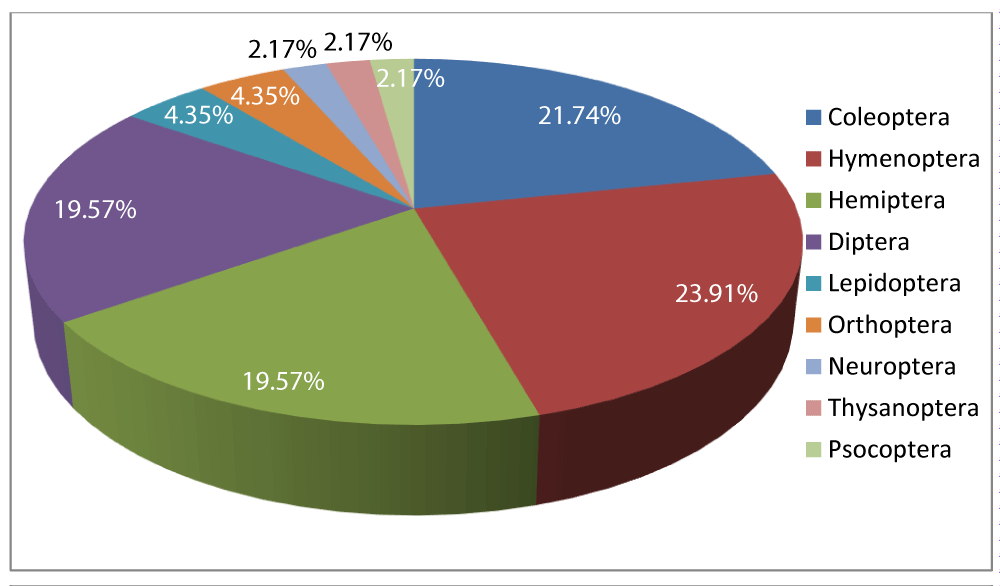
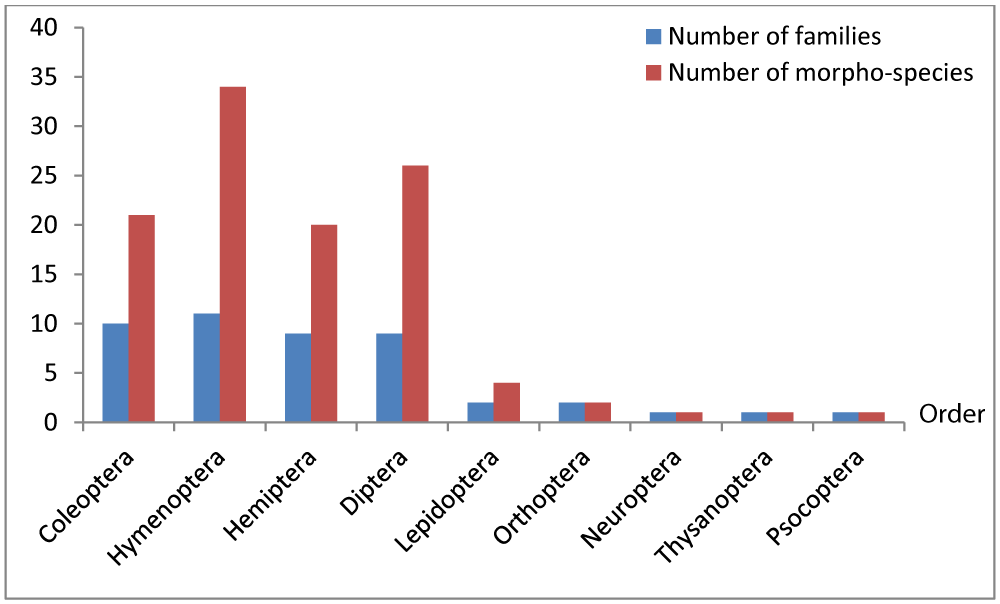
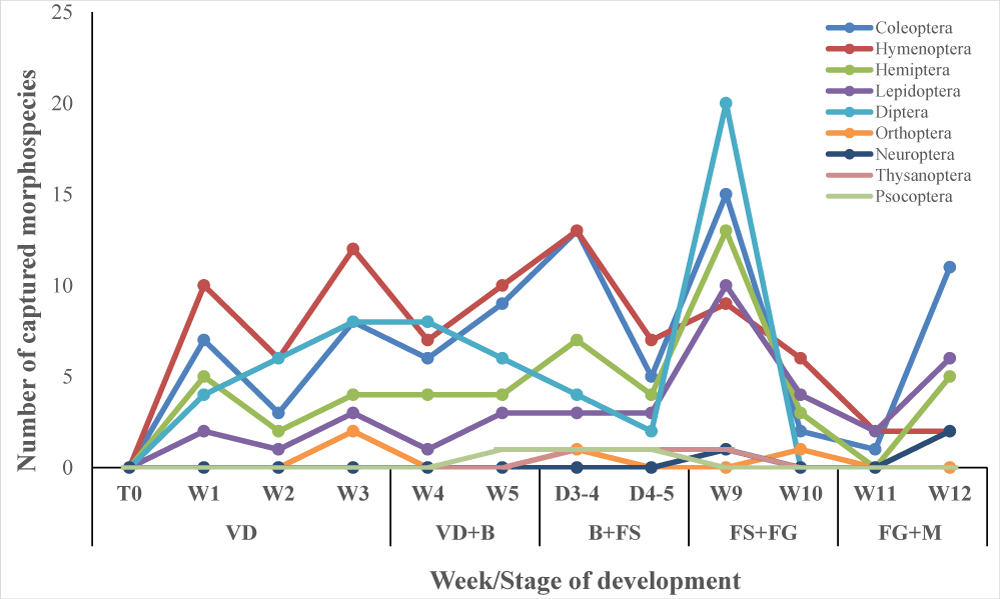
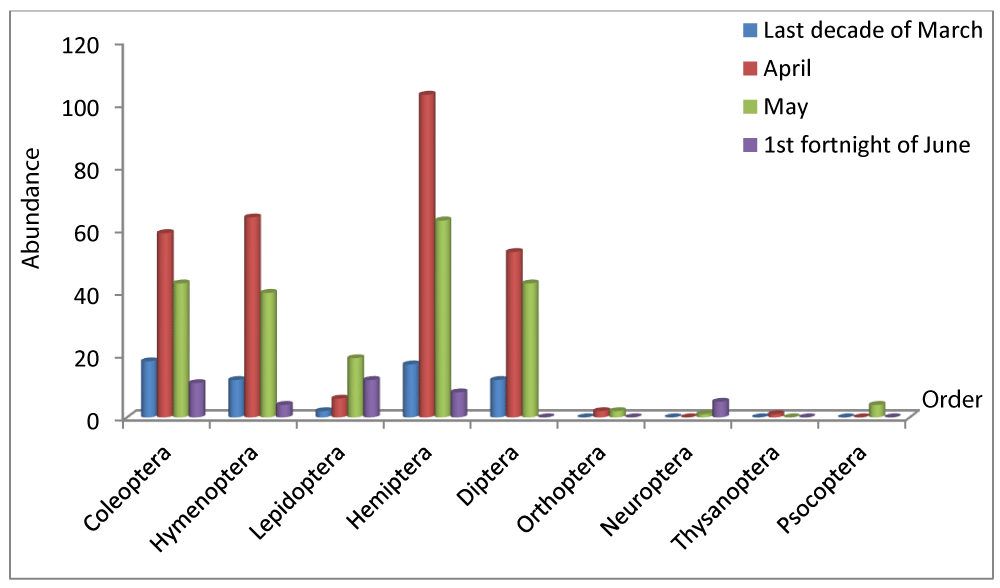

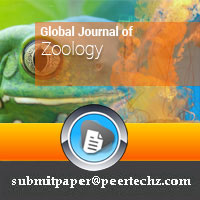
 Save to Mendeley
Save to Mendeley
